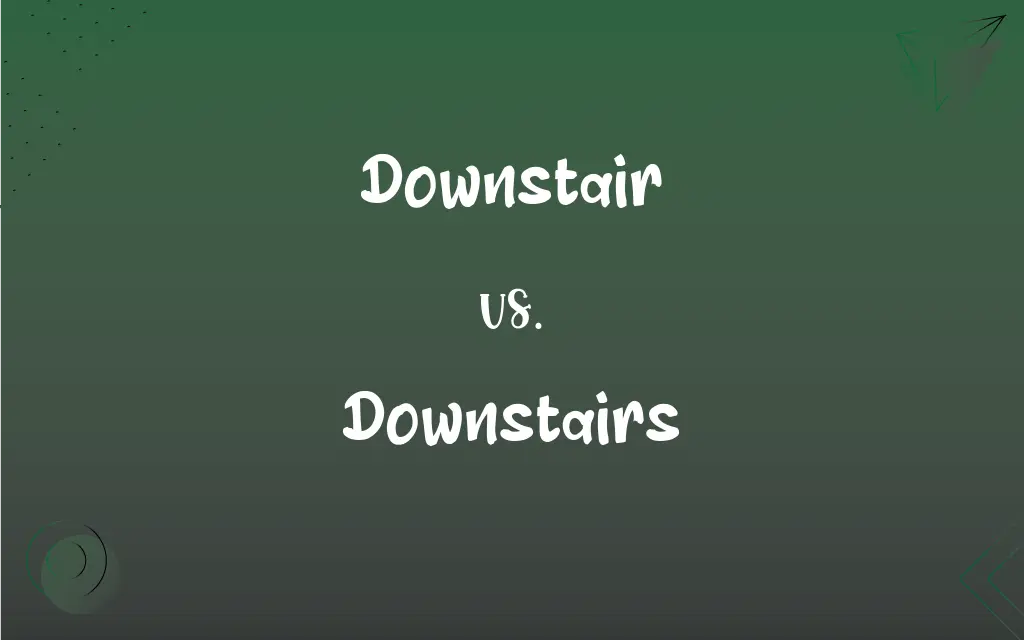Downstair vs. Downstairs: What's the Difference?
Edited by Janet White || By Harlon Moss || Updated on November 7, 2023
"Downstair" is a rare, often incorrect variant of "downstairs," which refers to the area or floors located below the main level of a building.

Key Differences
"Downstair" is seldom used and generally considered a nonstandard form of "downstairs," which designates the lower floor or levels of a structure. The prefix "down-" implies a lower position or descent, and while "stair" refers to the steps themselves, "stairs" is the more common form when referring to the concept of levels in a building. "Downstair," when encountered, is usually a misspelling or a typographical error. In contrast, "downstairs" is the correct term to describe something located on the lower floors of a building and is commonly used in both spoken and written English.
"Downstair," lacking the final -s, diverges from the standard plural form used in compound nouns describing parts of a building. In English, such compound nouns are typically plural when they refer to a system or network within a structure, as in "stairs" or "hallways." "Downstairs," with the -s, aligns with this convention, indicating not just one stair, but the entire lower level or the stairway as a whole. Therefore, "downstair" may confuse readers or listeners, as it suggests a singular form where a plural is expected.
In usage, "downstair" is not recognized by most dictionaries and is likely to be corrected to "downstairs" by spellcheckers and editors. "Downstairs" is the standard adverb or adjective, used to describe an action taking place on a lower floor ("He went downstairs.") or to qualify a noun as being on a lower floor ("The downstairs bathroom is available."). The distinction is important for clear communication, as using the standard "downstairs" ensures understanding and correctness.
The rarity of "downstair" is such that it is not included in most grammar rules or style guides, which focus on "downstairs" to describe locations beneath the ground floor. "Downstairs" can also be used metaphorically, to indicate a lower status or degradation ("Moving from CEO to an entry-level position felt like going downstairs."), a usage that "downstair" does not share, due to its nonstandard and uncommon nature.
"Downstair" may sometimes appear in older texts or in dialectal usage, but it remains an anomaly. "Downstairs," on the other hand, is universally recognized and used to indicate direction ("Let's move the furniture downstairs."), location ("The party is happening downstairs."), or even as a noun ("The downstairs has been renovated recently."), demonstrating its versatility and established place in the English language.
ADVERTISEMENT
Comparison Chart
Usage Frequency
Rarely used, often considered incorrect.
Commonly used in both spoken and written English.
Dictionary Inclusion
Generally not included in standard dictionaries.
Included in standard dictionaries.
Grammatical Number
Implies singular, but used incorrectly as plural.
Correctly used as plural.
Context
Not standard, potentially confusing.
Standard usage for lower levels of a building.
Metaphorical Use
Not used metaphorically due to rarity.
Can denote a decrease in status or level.
ADVERTISEMENT
Downstair and Downstairs Definitions
Downstair
Not standard usage.
The downstair area will remain closed today.
Downstairs
Situated on the lower floor.
The downstairs office is open.
Downstair
A misspelling of downstairs.
She accidentally wrote 'downstair' instead of 'downstairs'.
Downstairs
To or on a lower floor of a building.
We heard footsteps coming from downstairs.
Downstair
Rare variant that could be seen in non-standard English texts.
The downstair lighting needs to be fixed.
Downstairs
To a less important or prestigious level or position.
After the merger, they moved him downstairs to an entry-level position.
Downstair
Sometimes used in older or regional English.
The downstair rooms are cooler in the summer.
Downstairs
Indicating movement from a higher to a lower level.
She went downstairs to get some water.
Downstair
Might appear in dialectal variations.
He's waiting in the downstair hall.
Downstairs
Refers to the lower floor of a building.
Let's eat breakfast downstairs.
Downstair
(dated) downstairs
A downstair bedroom
Downstairs
Down the stairs
Raced my friend downstairs.
Downstair
On or of the lower floors of a building, especially the ground floor; as, the downstairs (or downstair phone; the house has no downstairs bathroom. Opposite of upstairs.
Downstairs
To or on a lower floor
Waited downstairs while her parents were getting dressed.
Downstair
On or of lower floors of a building;
The downstairs (or downstair) phone
FAQs
Is "downstair" correct English?
"Downstair" is generally a nonstandard variant of "downstairs" and is rarely used.
Can "downstairs" be used as an adverb?
Yes, "downstairs" can function as an adverb, as in "She walked downstairs."
Is "downstair" found in dictionaries?
"Downstair" is typically not found in standard dictionaries; "downstairs" is the correct term.
Does "downstair" have a metaphorical meaning?
No, "downstair" is not used metaphorically; "downstairs" can be used to imply a lower status.
Can "downstairs" refer to a location?
Yes, "downstairs" can refer to a location in a building, like "the party is downstairs."
How is "downstairs" used in a sentence?
"Downstairs" is used to indicate location or direction, e.g., "The library is downstairs."
Is "downstair" acceptable in formal writing?
"Downstair" is usually considered incorrect in formal writing; "downstairs" should be used.
Can "downstair" be an adverb?
While "downstair" can technically be an adverb, it is an unusual and nonstandard form.
Can "downstairs" be a noun?
Yes, "downstairs" can be a noun, as in "The downstairs is being renovated."
Can "downstairs" be used as an adjective?
Yes, "downstairs" can be an adjective, as in "the downstairs bathroom."
How can "downstairs" express movement?
"Downstairs" expresses movement towards a lower floor, as in "going downstairs for dinner."
Does "downstair" convey a specific floor?
"Downstair" does not clearly convey a specific floor due to its uncommon usage.
Is "downstair" a plural noun?
"Downstair" is not typically used; "downstairs" acts as a plural noun in context.
Do "downstair" and "downstairs" mean the same thing?
"Downstair" is often intended to mean the same as "downstairs," but it is not standard usage.
Would "downstair" be flagged in spellcheck?
Yes, most spellcheck programs would flag "downstair" as a potential error.
What part of speech is "downstairs" when it describes a room?
When describing a room, "downstairs" is an adjective, as in "the downstairs room."
Is "downstairs" ever spelled with a hyphen?
"Downstairs" is typically spelled without a hyphen.
Is "downstairs" used internationally?
Yes, "downstairs" is widely understood and used in English-speaking countries.
Is "downstair" ever correct in modern English?
"Downstair" is not standard in modern English; "downstairs" is the correct form.
Are there any contexts where "downstair" is appropriate?
"Downstair" may appear in dialectal or historical contexts but is otherwise not standard.
About Author
Written by
Harlon MossHarlon is a seasoned quality moderator and accomplished content writer for Difference Wiki. An alumnus of the prestigious University of California, he earned his degree in Computer Science. Leveraging his academic background, Harlon brings a meticulous and informed perspective to his work, ensuring content accuracy and excellence.
Edited by
Janet WhiteJanet White has been an esteemed writer and blogger for Difference Wiki. Holding a Master's degree in Science and Medical Journalism from the prestigious Boston University, she has consistently demonstrated her expertise and passion for her field. When she's not immersed in her work, Janet relishes her time exercising, delving into a good book, and cherishing moments with friends and family.
































































